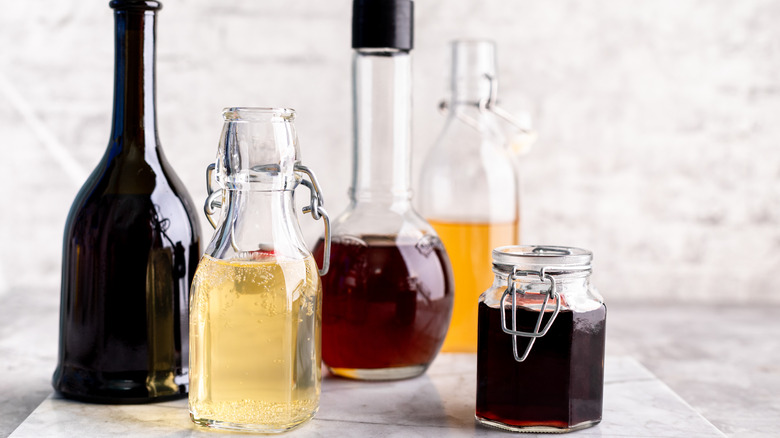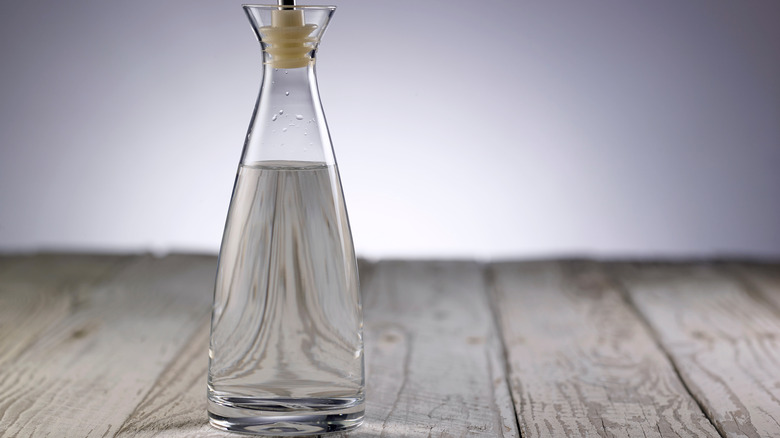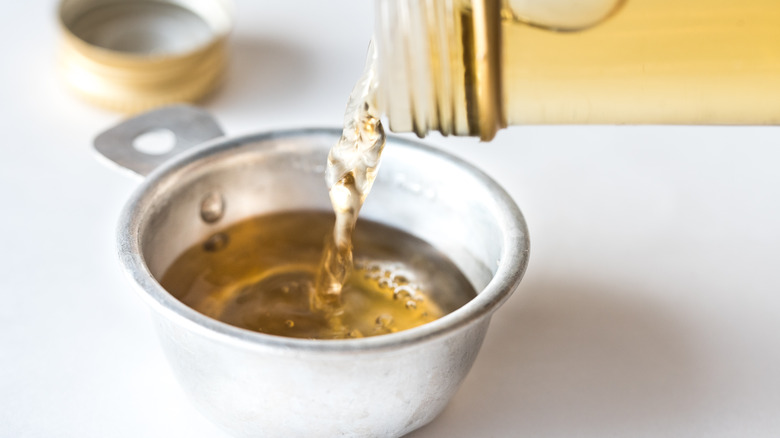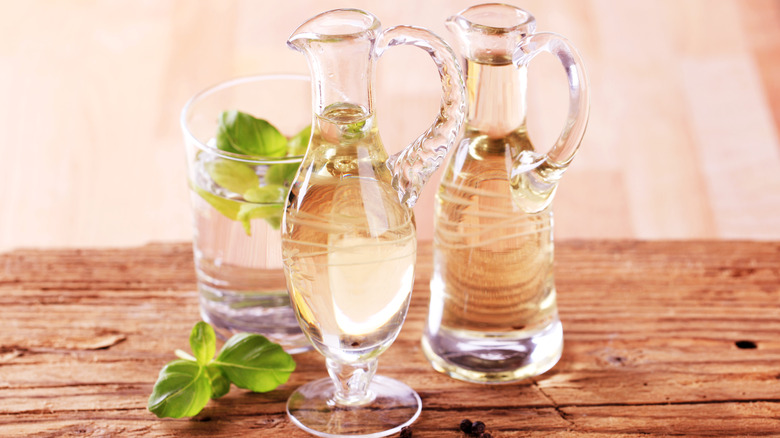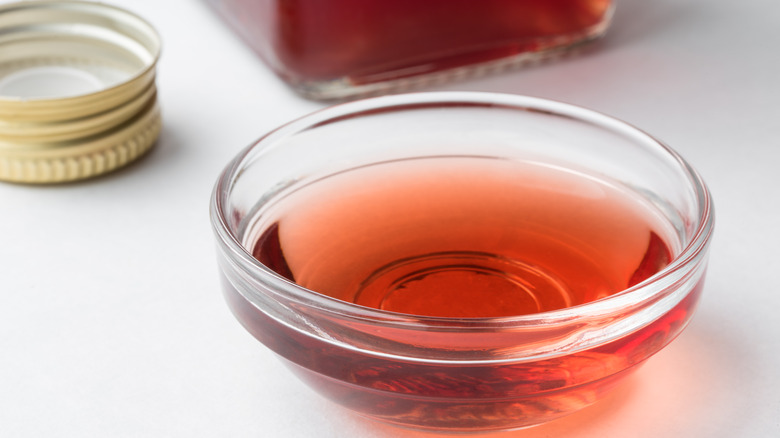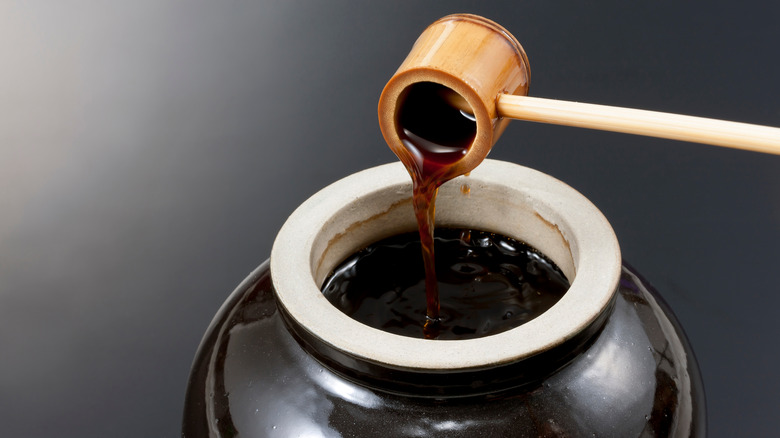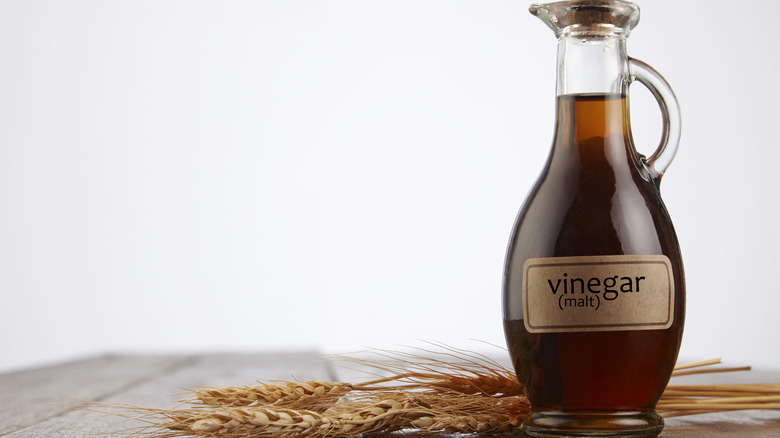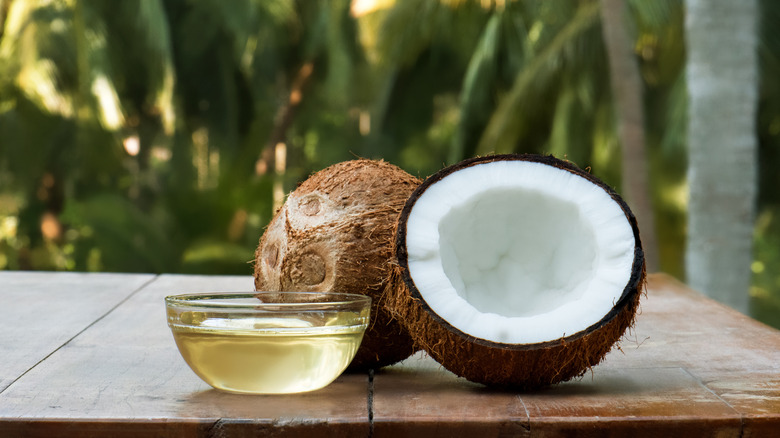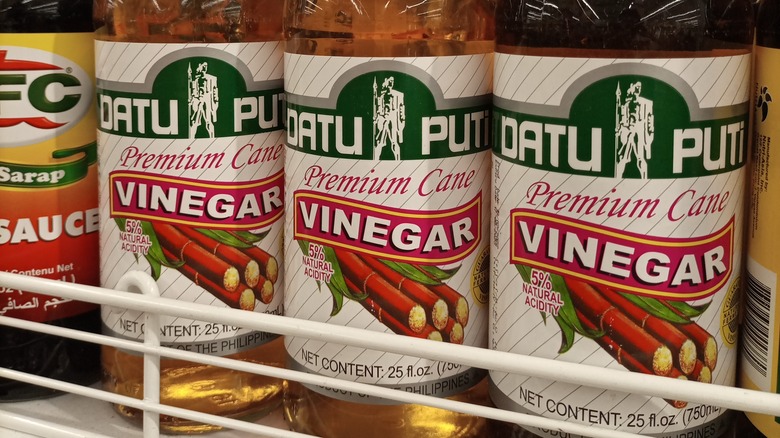14 Different Types Of Vinegar, And What To Do With Them
Vinegar is a staple ingredient that shows up everywhere. You may not give it too much thought, even though it's one of the most essential and versatile ingredients in the culinary world. It brings acidity to food, a crucial element that helps brighten and balance flavors. The acetic acid in vinegar can also act as a preservative, as it has antimicrobial properties which keep away or kill bad bacteria that can cause spoilage. There are few dishes that won't improve with a refreshing splash of tangy vinegar added to them.
It takes a few steps for vinegar to form. The base ingredient, which can be anything from wine to rice to fruit, must first attract yeast which will begin eating up the item's sugars, causing fermentation. These sugars become alcohol. If exposed to oxygen, this alcohol is then transformed over time into vinegar thanks to the actions of bacteria known as Acetobacter.
There are so many different styles of vinegar that it can be difficult to know which one to use in any given circumstance. Since it can be made from any product that has fermentable sugars, there are countless different flavor profiles. And the way the vinegar is treated after fermentation affects its flavor as well. Some vinegars are aged for complexity, while others are fresh and pungent. To help you understand the ins and outs of vinegar, here's a breakdown of some of the most common types and the best ways to use them.
1. White distilled vinegar
One of the most common and versatile types of vinegar, white distilled vinegar has an almost endless list of uses. It's usually made from grain alcohol and tends to have a very intense taste, albeit one that is fairly neutral, since it's not made from a flavorful base ingredient like wine or food. This is a workhorse type of vinegar, suitable not just for cooking but also cleaning and pickling and even gardening — the strong acetic acid component is great at killing weeds.
White distilled vinegar is a good option when you want to add bold acidity while maintaining a clean flavor, like in dressings and sauces, such as this homemade hot sauce. It really shines in pickling applications for the same reason. Its antimicrobial properties and neutral yet sharp aroma make it a helpful kitchen tool, able to naturally clean floors and surfaces as well as dishes and utensils. If you only have room for one vinegar in your kitchen, this is the one to opt for.
2. White wine vinegar
Not to be confused with white distilled vinegar, white wine vinegar is a very different substance. The flavor of this type of vinegar varies depending on the wine or blend of wines that are used as its base, but generally it's mildly fruity, with mellow acidity. White wine vinegar is great when you want to add a subtle sweetness to a dish while brightening it up. It goes nicely with delicate herb and vegetable flavors, like in this dill vinaigrette, and in marinades for lighter meats like fish and chicken.
Basic, simple white wine vinegars are typically made from a somewhat neutral blend of white wines, but you can also find specialty types made from specific wines, which they will name on the label. These tend to be more expensive, but their flavor will be more pronounced. Just like white wine itself, vinegars can also be fermented and aged in barrels to add more complexity; these will be dark golden in color and have a deeper flavor.
3. Red wine vinegar
Red wine vinegar is made from a red wine base. Just like white wine vinegar, this can be a blend of red wines or a single region or varietal — for example, Zinfandel vinegar is made from one grape, and Rioja vinegar is made of wines from that particular region in Spain. These specialty red wine vinegars will reflect the characteristics of the base wine, like peppery spice in a Shiraz or rich, dark fruit in a Cabernet Sauvignon.
Some red wine vinegars are fresh and tangy, while others have a richer, sweeter flavor due to fermenting or aging in wood barrels, similar to the way red wine is treated. Red wine vinegars make flavorful vinaigrettes and mignonettes. When used in pickling, they imbue the pickles with a pink hue which can be visually attractive. For marinades and braises, think of foods that red wine is typically paired with, like steak, lamb, and game meats, and they'll work well.
4. Champagne vinegar
A style of white wine vinegar, champagne vinegar is made from the same type of base wine that's used to create Champagne. This most commonly means wine made from the grapes Chardonnay and pinot noir. While this vinegar can be from the actual Champagne region of France, unlike with sparkling wine that bears that name, it doesn't have to be — you can find champagne vinegar from California, Italy, or anywhere else in the world.
No matter where it's made, champagne vinegar is characterized by its mild flavor, light and elegant texture, and delicate fruity and floral aromas. Since its typically subtler in flavor than other types of white wine vinegars, it should be used accordingly in dishes that won't overwhelm it. It makes a sleek vinaigrette well suited for light salads or being drizzled over seafood. Its nuanced flavors and acidity shine in recipe like artichokes barigoule, in which a more intensely flavored vinegar might take over the recipe, but champagne vinegar adds the perfect balance.
5. Sherry vinegar
Like the wine that it's made from, sherry vinegar, or vinagre de Jerez, is made in a specific region of Spain. While there are a few different styles, the most common sherry vinegar is made of wine crafted from the Palomino grape, which is a light, fairly neutral-tasting wine with good acidity, making it the perfect base for this type of vinegar. That's because it's the aging process for sherry that gives the wine, and hence the vinegar, its unique flavors, not necessarily the grape itself — a distinctively rich, nutty flavor dominates, contrasting beautifully with its brisk acidity. Sherry vinegar is perfect in Spanish dishes, as you might expect. A few drops add complexity to gazpacho and sauces like romesco.
There are different types of sherry vinegar you might see on shelves. The most basic is simply labeled sherry vinegar and is aged in wooden barrels for at least six months and up to two years. If it's labeled reserva, that means it's been barrel-aged from two to 10 years and will have a richer, more intense flavor. Gran reserva sherry vinegar is aged over 10 years and is considered top-tier in quality. Pedro Ximénez and Moscatel are labeled after the grapes they're made from — both of these are sweet styles of sherry vinegar.
6. White rice vinegar
Alternatively called rice wine vinegar, white rice vinegar is crafted from rice that has fermented into alcohol and is quite commonly used in cuisines all over Asia. It's fairly mild in taste and acidity and is therefore a versatile staple in the kitchen. White rice vinegar adds a nice, mellow flavor to salads with light, fresh ingredients, like this cucumber salad. You can also add it to brighten up noodle and rice dishes and stir-fries, and it makes an excellent component in dipping sauces for dumplings.
Most rice vinegars only have two ingredients: rice and water. You may see some labeled as "seasoned," and if you check the ingredients list, you'll see either salt or sugar added, or sometimes both. Keep in mind these will have a slightly different flavor than the unseasoned versions, and you may need to adjust your recipes accordingly to avoid unwanted sweet or salty flavors.
7. Chinese red vinegar
A staple of Chinese cooking, Chinese red vinegar, also known as red rice vinegar, has a relatively mild acidity, so it gives foods a mellow tang rather than a sharp punch. While some brands use artificial coloring to achieve the signature red hue, Chinese red vinegar's natural color comes from a particular strain of mold called Monascus purpureus, which grows on white rice which can then be fermented.
Like white rice vinegar, Chinese red vinegar makes a good addition to dipping sauces and dressings. It can be drizzled over seafood and mixed into soups to add a subtle seasoning. Chinese red vinegar can be brushed or basted onto the surface of food as it's cooking to add a vibrant red color — with whole skin-on poultry, such as duck or chicken, this process will also make the skin extra crispy. And since its acidity is mild, it won't overwhelm the food.
8. Black vinegar
There are many types of black vinegar, also known as Chinese black vinegar and Chinkiang vinegar. It's often made with black sticky rice or other rice, although some varieties are crafted from other cereal grains such as wheat. Often aged for months or even years, black vinegars have pronounced and deep flavors, with lots of malty and savory notes, and are loaded with umami. The tang of acidity works well to balance out the rich, earthy taste of this vinegar style.
There are many different regional versions of black vinegar, from all over China and throughout Korea, Taiwan, and Japan. Each will have subtle differences and recipes it's most suitable for, but generally they can be used fairly interchangeably. Black vinegar can be drizzled over noodles, used to glaze meats and vegetables, or mixed into dipping sauces and dressings. Any time you want to add a pop of acidity and layers of umami to a dish, reach for the black vinegar.
9. Malt vinegar
No pub table would be complete without a bottle of malt vinegar. A compulsory accompaniment to fish and chips, this tangy and nutty condiment cuts nicely through fatty fried foods. It's made from malted grain, the same base that's used to create beer and spirits like whiskey, which is fermented a second time to create vinegar. The flavor of malt vinegar is fairly aggressive compared to many of the other, more subtle vinegars out there, although sometimes it's aged in order to mellow its sharp edges.
Aside from its suitability as a drizzle or dip for fish and chips, it works well in strongly flavored glazes, steak sauces, and barbecue sauces. More delicate ingredients will become easily overwhelmed by malt vinegar's intensity, so it's best with robust and hearty fare. It adds a lot of flavor when used for pickling and is a great addition to condiments like chutney, mustard, and mayonnaise or aioli.
10. Apple cider vinegar
There are a lot of tales being spun about apple cider vinegar's seemingly mystical wellness powers, from aiding in weight loss to improving blood pressure. Turns out, it does have some minor health benefits, according to UChicago Medicine, but rather than being considered a miracle cure for all manner of ailments, it should be praised and utilized for its culinary versatility — any positive side effects are just a bonus.
Made from fermented apple juice, apple cider vinegar is pleasantly tangy, with a fruity sweetness that complements many other flavors. It's great in spicy sauces and glazes, as the fruitiness tones down harsh heat. That same quality adds a unique flavor to pickles, and it's especially suitable for fruit like pickled strawberries. Apple cider vinegar makes deliciously tart, bright vinaigrette dressings.
Some apple cider vinegars are not filtered before bottling, which leaves them cloudy, and you may even notice solids floating in the liquid. This is not a flaw and doesn't indicate spoilage — it's what's known as the mother, which is simply bacteria left over from the fermentation process. Although it can add an odd texture, it's safe to consume.
11. Coconut vinegar
Many South and Southeast Asian cuisines utilize coconuts in lots of different forms, including coconut vinegar. Made from fermented coconut sap, it's a staple of Filipino cooking. While it was once difficult to track down outside of regions that use it regularly in their dishes, it's recently become a darling of the wellness world and is becoming more widely available everywhere.
Coconut vinegar has a unique flavor that's fairly mellow and is often compared to champagne vinegar in that regard. Like apple cider vinegar, it is sometimes bottled unfiltered with the mother. It may have a faint coconut taste and a light, fruity sweetness, but it's subtle and tangy, making it a versatile vinegar. It complements delicate ingredients well, like light fish and poultry, whether it's used in a marinade before cooking or added afterward as seasoning. Coconut vinegar adds a nice complementary touch to anything with tropical flavors — try it in this recipe for coconut rockfish with mango salsa, and you'll see it truly shine.
12. Cane vinegar
Another vinegar that's commonly used in Filipino cooking, as well as other Asian cuisines, is cane vinegar. Made from fermented sugarcane, this type of vinegar isn't as sweet as you might assume based on its main ingredient. It's rather mild in flavor, which makes it versatile, and has a sharp sour tang. Suitable for marinades, dressings, pickling, you name it, it's a good go-to vinegar to have around for all kinds of applications thanks to its fresh, neutral character.
Cane vinegar is the type most often specifically called for in adobo recipes, so make sure to use it if you're going to authentic Filipino flavor. Try it in this Filipino chicken adobo dish. Cane vinegar is also present in Cajun and Creole cooking, and is produced in Louisiana. This fried shrimp and oyster po'boy calls for cane vinegar aioli. Try cane vinegar in slaws and remoulades, too, for a clean, fresh tangy zip.
13. Honey vinegar
Many vinegars that have the word "honey" on their labels are not actually made from honey but are simply a different type of vinegar with honey added to sweeten it up. However, honey itself can be fermented and turned into vinegar, creating a unique product that expresses the flavors present in the honey while adding a tangy kick. First, honey is left to ferment until it becomes mead, which is then turned into vinegar. Think of any food you'd add honey to — barbecue sauce, mustard, glazes for meats or vegetables — and honey vinegar will work great with those flavors.
Honey vinegar is particularly delightful when used in cocktails. It adds a complex, sweet, and sour dimension to drinks and matches up well with just about any base spirit, from vodka to bourbon to scotch. It's also a great choice for shrubs, also known as drinking vinegars, when combined with sugar and fruit of your choice.
14. Balsamic vinegar
Balsamic vinegar is one of the most complex and unique vinegars in the world. It's made from grape must, or unfermented juice pressed from wine grapes, which is left to age in wood barrels to age until it is incredibly rich and concentrated. Not all balsamic vinegars are the same — you might notice when shopping their prices can range dramatically. That's because there are several different categories that indicate certain production and aging requirements, so it's helpful to know the basics to find which bottle is best for your purposes.
The balsamic vinegars at the highest end of the spectrum are known as traditional, or "tradizionale" in Italian. These vinegars will be labeled with the letters DOP, which indicates that they are heavily regulated in order to guarantee the highest quality. Aged at least 12 years and sometimes for a few decades, these balsamic vinegars are super concentrated in both flavor and texture, thanks to years of evaporation. They shouldn't be cooked or used in any recipe that will compromise their luxurious texture and elaborate flavors. A few drops or drizzles atop dishes are all you need.
Other balsamic vinegars that go through less rigorous processes may be labeled IGP, indicating some aging and regulation requirements. Then there are American-made versions, which vary in quality, as well as cheaper Italian balsamic vinegars that are best for cooking with. Whichever one you use, balsamic's deep, sweet, and tangy flavor is unmistakable and great in dressings, sauces, and glazes.
